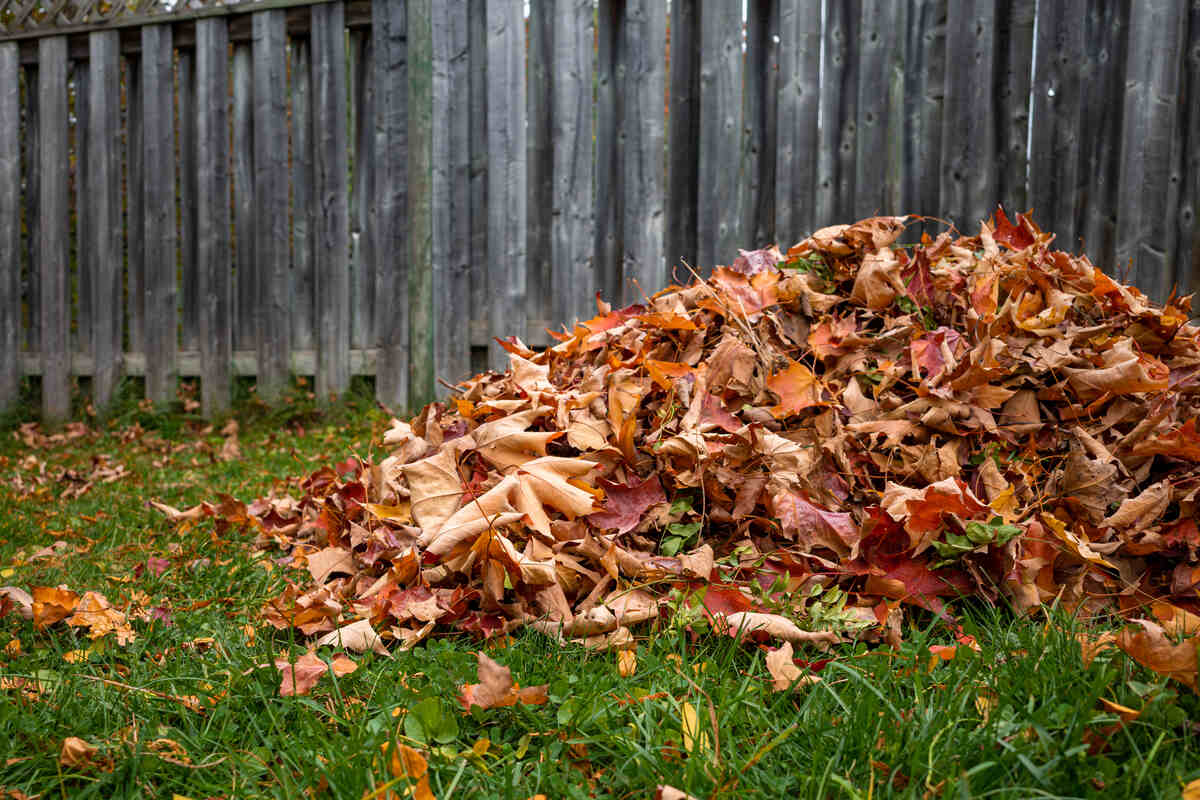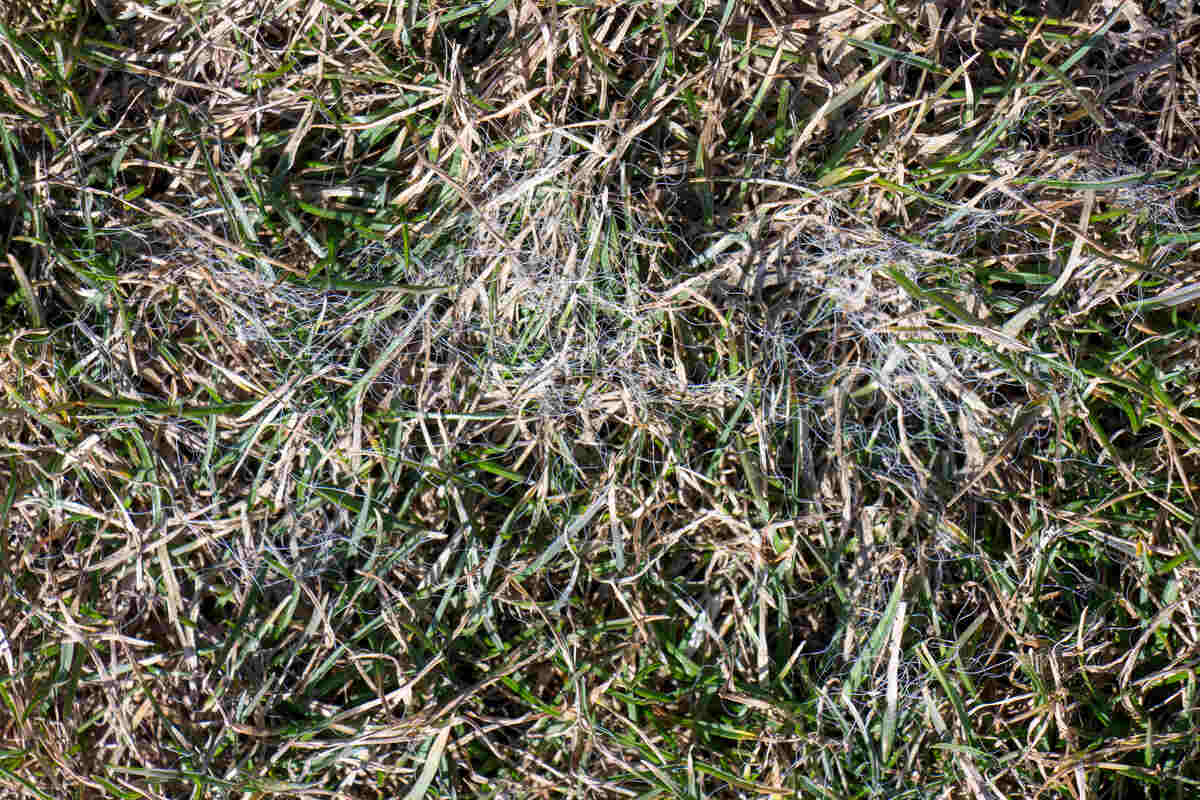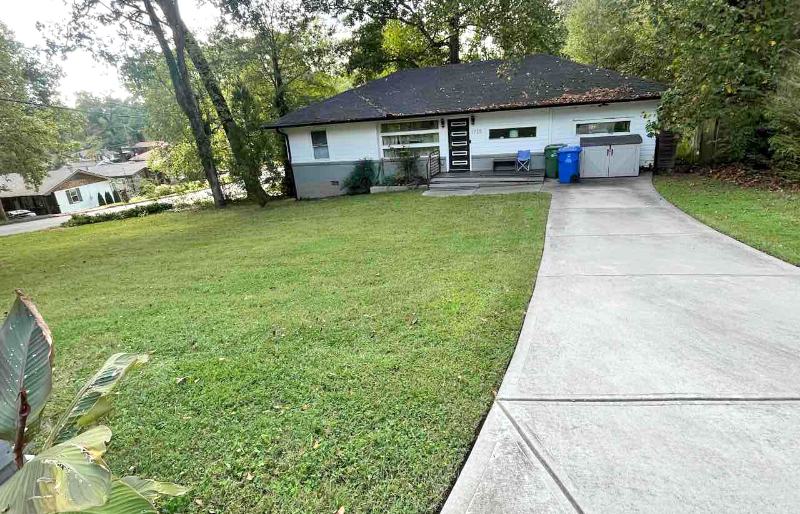
Leaving leaves on your lawn results in smothered, disease-infested grass, decreased curb appeal, and weed infestations.
Letting leaves cover up to 50% of your lawn is perfectly fine, but any more than that, and you’re asking for trouble. There’s a fine line between letting your lawn go au naturel and accidentally suffocating the grass.
Suffocates Grass
When there is a pile of leaves covering your grass, it’s impossible for sunlight to reach the turf. Too many leaves hinder airflow and smother your grass, stunting its growth. This leads to serious lawn issues, causing your grass to brown.
Heavy leaf cover can kill a patch of grass in a matter of weeks, especially in warmer weather. Mulch-mow or remove them once per week or when leaves cover around 50% of the lawn to prevent damage.
| Protect your grass from being smothered by heavy leaf fall with LawnStarter’s leaf removal service. Last year, we completed nearly 12,000 leaf removal jobs at an average price of $158 per service and received an average rating of 4.3/5 from our customers. |
Invites Fungal Growth

Moisture attracts fungal growth, and there will certainly be excess moisture if wet leaves are sitting on your lawn. Decaying, rotting leaves attract fungi and mold growth, especially in rainy and humid climates. If you don’t rake the leaves before winter, it leaves your lawn at an increased risk for fungal diseases such as snow mold, dollar spot, or pythium blight.
“Leaving whole leaves on the lawn through fall and winter can lead to disease issues,” says Alison O’Connor, Extension professor of horticulture at Colorado State University.
See Related: Lawn Fungus Treatments: Costs, Types, and Do They Work?
Attracts Pests
Pests such as mice and voles might decide to turn your leaf pile into their winter condo, causing extensive damage in the process. Leaves create a haven for many types of pests, including:
- Insects
- Reptiles
- Rodents
During the chilly season, animals seek shelter in leaf piles. Once these pests move into the bunches of leaves sitting on your lawn, there is a higher likelihood that they will find their way into your home.
Allows for Weed Growth

Smothered grass becomes sparse and sickly, creating bare patches where weeds can grow. Removing the leaves helps keep your grass robust, healthy, and resistant to weed growth.
See Related:
Causes Drainage Issues
When your gutters and drains are clogged with leaves, water is unable to properly drain from your roof, landscaping, or lawn. This causes drainage issues, such as:
- Standing water
- Clogged gutters and storm drains
- Water overflowing from gutters
- Flooding
- Roof leaks
- Mold and mildew
- Damage to surrounding plants
- Soil erosion
- Mosquitoes
- Soggy, muddy lawn
See Related: 7 Ways to Improve Drainage in Your Yard
Creates a Fire Hazard
Fire spreads quickly when it has dry tinder like crisp, dry leaves. When dry leaves cover your lawn, it can endanger your house or any other outdoor wooden structure or furniture in your yard.
To keep your home hazard-free, regularly rake up the leaves on your property, especially if your area is experiencing a drought or is prone to wildfires.
See Related: How to Create Fire-Resistant Landscaping
Delays Spring Recovery
If leaves sit on your lawn all winter, it will inhibit grass growth in the spring. Additionally, in the springtime, it worsens damage to the grass caused by wildlife such as voles or mice.
Chilly winter weather puts enough stress on your lawn, so layers of leaves smothering your grass will only further stress your turf by depriving it of sufficient sunlight and airflow. As a result, it will be harder for your grass to recover come spring, and it may even kill your grass over winter.
See Related: How to Repair Vole Damage
Decreases Home’s Curb Appeal
Leaves all over your lawn make your yard look unkempt, and it can signal that you don’t really care about your home.
General landscape upkeep – mulching, pruning shrubs, mowing – has a 104% return on investment, according to the National Association of Realtors. If you’re selling your home, your front lawn is your potential homebuyer’s first impression. Leaves, twigs, and a generally disheveled lawn can torpedo your home sale prospects.
See Related: Lawn and Landscape Items with the Greatest ROI
FAQ About Removing Fallen Leaves
Mulching is the best way to clean up fallen leaves.
“It’s important that you mulch or chop the leaves,” says O’Connor. “The easiest way to manage leaves is to mulch them into the turf using your lawnmower.” Mulching also reduces weed growth and returns organic matter and nutrients to your grass, she adds.
If you don’t want to mulch, you can also rake your leaves or use a leaf blower or leaf vacuum to clear your yard of fallen leaves.
See Related: Best Tools to Use to Collect Autumn Leaves
You should mulch or remove the leaves in your yard within days after they drop onto your lawn. “In general, leaf removal is something that happens over a period of weeks, because trees don’t usually drop their leaves all at once,” says O’Connor.
It’s best to deal with the leaves in small batches as they fall rather than wait to start after your tree has unloaded all its leaves. Leaf removal or mulching is much harder when there are more leaves in your yard.
You can allow up to 50% leaf coverage on your lawn. It should be a light dusting, not a full-on blanket. This way, you get all the benefits without the downsides. “As long as you can still see green grass through the leaf layer, the layer is not too thick,” says O’Connor.
Leave the Leaves to a Lawn Care Pro

If leaves have buried your lawn, it’s time to take action. While raking leaves is a simple but back-breaking DIY task, it can take hours to clear a large lawn, leaving you exhausted.
If you don’t want to deal with an arduous and time-consuming DIY leaf-raking job, call a LawnStarter pro when the leaves start to fall. With LawnStarter’s leaf removal services, you can have your yard clear of leaves in no time.
See Related:
- How Much Does Leaf Removal Cost?
- What to Do With Fallen Leaves in Your Yard
- How to Remove Leaves From Mulch and Flower Beds
Sources:
- Alison O’Connor, Extension professor of horticulture at Colorado State University Extension, Fort Collins, CO. Personal interview.
- “Good Question: Do You Really Need to Rake All Those Leaves?” By Sam Bauer, Extension educator. University of Minnesota.
- “Is It Absolutely Necessary to Rake the Leaves in the Fall or Can it Wait Until Spring?” University of New Hampshire.
- “Leave the Leaves. To Rake or not to Rake?” By Diana Alfuth, horticulture educator. University of Wisconsin Extension.
- “This Fall, Leave the Leaves!” By Brooke Franklin, natural resource specialist. U.S. Department of Agriculture.“2023 Remodeling Impact Report: Outdoor Features.” National Association of Realtors.
Main Image Credit: Colin Temple / Adobe Stock Free / License